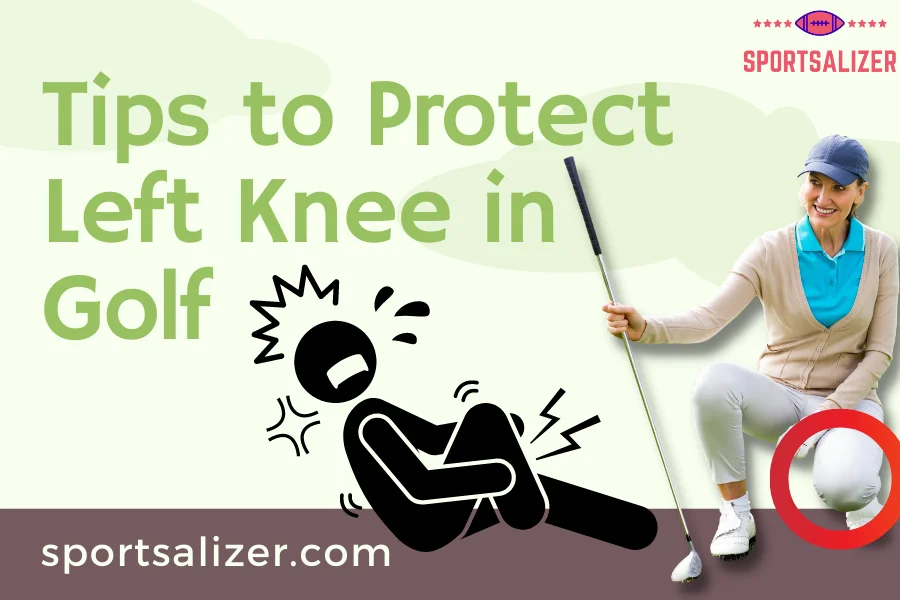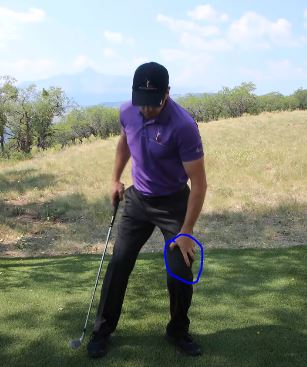4 Secret Tips to Protect Left Knee in Golf

Being a golf player, it is essential to have the proper posture. And of course, for that, one needs to be free of all kinds of pain, especially in nth knee areas. If you have noticed carefully, you would understand that the maximum torque during the swing is around the left knee region. So it is very evident that the left knee is the part of the body to undergo maximum stress.
So how to protect left knee in golf? There are various techniques by which you can protect your left knee, like practicing your style, taking it slow, improving your conditioning, and using the proper tools or equipment.
Contents
Here are the steps on how to protect Left Knee in Golf

A few steps need to be followed if you are also looking for some good answers on “How to protect left knee in golf?” We shall explain each of the steps in detail to make it straightforward for your understanding.
Step 1: Improve your technique.
Pain in the left knee of the golfers is the most common type of pain that the players experience. This is the rotational force that the knees undergo during the swing. So it is essential to reconstruct the swing mechanics the golfers apply to minimize the amount of torque in the knee joint. It should also be rebuilt to reduce the risk for injury of the joint. There are a few ways by which you can achieve this.
- The very first thing that you should try to do is to point your feet “out.” Utilizing this technique will help you to put your knee at a “pre rotated position automatically.’ This position, in turn, will help to minimize the number of twists on the left knee during a swing. This is the primary step that one needs to follow if they are wondering, “How to protect left knee in golf?”
- The second step for accomplishing this technique is to lift your heel or your toes “upward when you swing.” Both the processes work on the same concept: it allows your foot to play the role of the picot. When the foot is used as a pivot instead of being firmly planted, this process again helps to reduce the amount of twisting on the knees and hence this is a very effective solution to one of the most prevalent questions asked, which is “how to protect your left knee in golf”.
- If you are thinking about “How to protect left knee in golf?” the last step to improve your technique is to lift your entire foot off the ground. This is one of the most intricate steps to grasp. Hypothetically, this might be the best to prevent all kinds of knee injuries that the golfers experience. But, it is challenging to implement it in real life. If the player can do this step right before the ball is hit, then it would minimize the amount of torque significantly that one puts on their joint.
Step 2: Take it slow.
A study from the American Journal of sports medicine found that 82.6% are caused due to overuse. So the very first thing that one must follow in golf or any sport is to listen to your body first. As already mentioned, every swing causes a strain due to the torque in the knees. So, if we were to answer to “How to protect left knee in golf”, the solution would be to give your body some rest if you are not feeling right.
But taking some rest is not always an option. So how to protect the left knee in golf in that situation? What you can do best is rely on shorter or more precise shots than going for the ones that require power. It would help if you always remembered that getting better at any sport is not always about pushing past your limits. It would be best if you always gave your body enough time to rest and rejuvenate from the stress that it experiences.
The best way to increase your ceiling is to build it up gradually. Pushing past your limits in one go is never the process. It would be best to make the slow but steady progression to improve your game daily. This is one of the basic steps to the question, “How to protect left knee in golf?”
Step 3: Improve your conditioning
It has been found that the solution of “How to protect left knee in golf?” is to improve flexibility, strength, and stamina in the game. Most of the injuries that the golfers’ experience are due to poor strength or flexibility or sometimes both. Also, there are cases where the golfers had injured themselves because they had not warmed up properly before they started playing.
Thus, coaching yourself to be more flexible and sturdy reduces the likelihood of injury. On the other hand, failure to do so may increase your chances of developing knee problems down the line.
Step 4: Using the right equipment
The last but not the least significant answer to the question on “How to protect left knee in golf?” is to utilize the right gear. One should use the equipment that fits their style and fits them physically. For example, if the shoes you are using currently have long cleats, that might be a problem. The spikes on the boots make it harder to use the feet as a pivot instead, they firmly plant the foot. This often results in putting more torque on your left knee. So, if you are still figuring out “How to protect left knee in golf?” use shoes that have shorter cleats.
On a final Note
“How to protect left knee in golf?” is one of the most commonly asked questions. This is because knee pain is the most common type of pain that golfers experience. It takes away the fun of the game and affects the performance significantly. To prevent this, you can practice the steps mentioned earlier to condition your body better and excel in the game.
FAQs on How to Protect Left Knee in Golf
What is the most common golf knee injury?
Meniscus tears are not the most prevalent golf injury. After all, it’s natural to believe that knee meniscus tears only occur in sports involving quick, twisting movements. Regrettably, the reality is blander. The rotational motion of your golf swing, or simply squatting down to line up a putt or remove the ball from the hole, can tear through the knee meniscus. Follow the steps mentioned above to know how to protect your left knee in golf!
What’s the best advice for getting back into the game after a knee injury?
Keep a more upright posture.
Practice only with wedges and short irons at a driving range.
Begin with short swings (half and three-quarter), gradually increasing to a full swing.
Wear spike-free shoes with arch supports.










